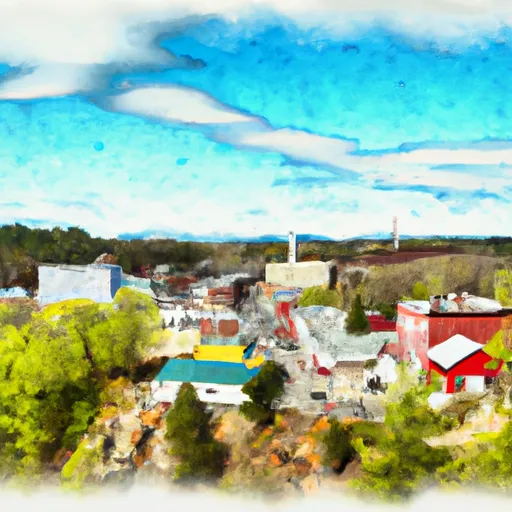-
 Snoflo Premium
Snoflo Premium
Get unlimited access to all our content
With no Ad interruptions! - Start Your Free Trial Login with existing account
Steep-Falls
Eden Index
Climate
7.8
•
Recreation
1.7
•
Community
1.1
•
Safeguard
4.0/10

Steep Falls, Maine is a small rural town located in Cumberland County, in the northeastern United States. Known for its picturesque landscapes and tranquil atmosphere, Steep Falls offers a diverse climate throughout the year. Summers are mild and pleasant, with temperatures ranging from the mid-70s to low 80s Fahrenheit. Winters, on the other hand, can be cold and snowy, with temperatures often dropping below freezing.
The town is blessed with a rich hydrology system, featuring numerous lakes, ponds, and streams. Popular water bodies include Steep Falls Pond, which offers opportunities for fishing and boating, as well as the Saco River, which runs through the town and is perfect for kayaking and canoeing.
Outdoor enthusiasts will find a myriad of recreation opportunities in Steep Falls. The surrounding forests provide ample space for hiking, camping, and wildlife observation. The area is also known for its excellent hunting, particularly for white-tailed deer and upland game birds. Winter sports enthusiasts can enjoy activities like cross-country skiing and snowshoeing in the snowy landscapes.
Overall, Steep Falls, Maine offers a serene and picturesque environment, with a wide range of outdoor activities to suit nature lovers and adventure seekers alike.
What is the Eden Index?
The Snoflo Eden Index serves as a comprehensive rating system for regions, evaluating their desirability through a holistic assessment of climate health, outdoor recreation opportunities, and natural disaster risk, acknowledging the profound impact of these factors on livability and well-being.
Climate Health Indicator (CHI): 7.8
Steep-Falls receives approximately
1242mm of rain per year,
with humidity levels near 78%
and air temperatures averaging around
7°C.
Steep-Falls has a plant hardyness factor of
5, meaning
plants and agriculture in this region thrive during a short period during spring and early summer. Most
plants will die off during the colder winter months.
By considering the ideal temperature range, reliable water supplies, clean air, and stable seasonal rain or snowpacks, the Climate Health Indicator (CHI) underscores the significance of a healthy climate as the foundation for quality living.
A healthy climate is paramount for ensuring a high quality of life and livability in a region, fostering both physical well-being and environmental harmony. This can be characterized by ideal temperatures, reliable access to water supplies, clean air, and consistent seasonal rain or snowpacks.
Weather Forecast
Streamflow Conditions
Saco
Area Rivers
Saco
Snowpack Depths
Saco
Reservoir Storage Capacity
Saco
Groundwater Levels
Recreational Opportunity Index (ROI): 1.7
The Recreational Opportunity Index (ROI) recognizes the value of outdoor recreational options, such as parks, hiking trails, camping sites, and fishing spots, while acknowledging that climate plays a pivotal role in ensuring the comfort and consistency of these experiences.
Access to outdoor recreational opportunities, encompassing activities such as parks, hiking, camping, and fishing, is crucial for overall well-being, and the climate plays a pivotal role in enabling and enhancing these experiences, ensuring that individuals can engage in nature-based activities comfortably and consistently.
Camping Areas
| Campground | Campsites | Reservations | Toilets | Showers | Elevation |
|---|---|---|---|---|---|
| Salmon Point City Campground | None | 280 ft | |||
| Crocker Pond | 7 | 909 ft |
Nearby Ski Areas
Catastrophe Safeguard Index (CSI):
The Catastrophe Safeguard Index (CSI) recognizes that natural disaster risk, encompassing floods, fires, hurricanes, and tornadoes, can drastically affect safety and the overall appeal of an area.
The level of natural disaster risk in a region significantly affects safety and the overall livability, with climate change amplifying these risks by potentially increasing the frequency and intensity of events like floods, fires, hurricanes, and tornadoes, thereby posing substantial challenges to community resilience and well-being.
Community Resilience Indicator (CRI): 1.1
The Community Resilience Indicator (CRI) recognizes that education, healthcare, and socioeconomics are crucial to the well-being of a region. The CRI acknowledges the profound impact of these elements on residents' overall quality of life. By evaluating educational resources, healthcare accessibility, and economic inclusivity, the index captures the essential aspects that contribute to a thriving community, fostering resident satisfaction, equity, and social cohesion.

